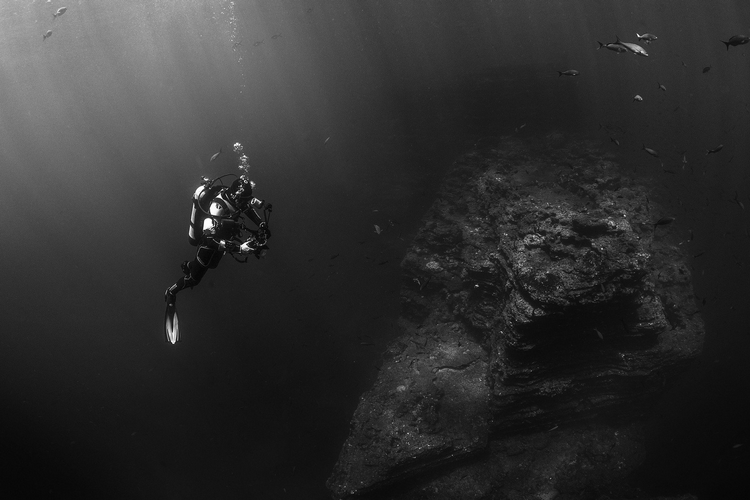
This article about how to deal with a down current was inspired by an incident I was involved in when I ended up at 65 metres (213 feet) deep!
That’s dangerously deep on regular atmospheric air, which is why it’s important to know how to deal with a down current. How you deal with a down current is to swim at a 45° upward angle away from the wall whilst adding air to your BCD as you swim. If this doesn’t work grab a stationary object to stabilise yourself. Use other objects to crawl to the surface or wait until you’re ready for another attempt at a swim to the surface.
The best way to do more diving is to book yourself on a scuba diving liveaboard. You can check the latest and best deals on liveaboards using the following window:
What would you do in this down current situation?
“After backward rolling off the side of a rib boat into abysmal depth water (i.e. 1,000 metres deep below or 3,281 feet), you begin your normal descent to a planed dive of 30 metres (98 feet). But as start your descent to your planned depth you are suddenly overcome by a strong downward current. It’s a force you’ve never felt before, except perhaps from diving on a normal and planned drift dive.
The strong downcurrent is pushing you ever deeper so you pass your planned depth of 30 metres. Instinctively you begin to fin like crazy to stop your decent into the abyss. But no matter how hard you kick, the dangerous downcurrent is so strong you keep descending deeper and deeper.
Then you add air to your BCD at a depth of 50 metres (164 feet). But the downcurrent is still taking you deeper. You add yet more air to your BCD and continue to kick your fins furiously using up valuable air as you get out of breath. Your depth has now passed 60 metres (197 feet).
You try to remain calm and not panic as your depth maxes out at 65 metres (213 feet), at which point you begin to ascend back to safer depths.”
I’ve just described an event that happened to me when diving in the Red Sea. The dive was on the Elphinstone Reef, which is known for currents, but not necessarily downdraft or vertical downward currents.
What is a down current and what does it mean?
Downcurrents can occur when a horizontally flowing current hits the face of a wall or steep drop off. As the current hits the wall at right angles, and if the water depth is sufficient, the current will follow the wall down. Downcurrents can also occur when two opposing currents meet, as they flow over one another.
The meaning of a downcurrent is a downward-moving current.
Video getting caught in a downcurrent – PANIC (Sipadan, Island) diving Malaysia
What started as a calm dive ended up to be a heart-pumping one when we hit a strong downcurrent during one of our dive in Sipadan Island.
And another video of a downcurrent with a vortex:
What to do if you’re caught in a dangerous down current
There are a number of things you can do to to deal with a downward vertical current.
- Don’t panic and stay calm.
- Fin against the downcurrent.
- Add air to your buoyancy control device (BCD) to counteract the downward force.*
- To stabilise yourself grab hold of a stationary object until the down-welling subsides or use other stationary objects to climb your way to the surface. Or hold-on until you’re ready to make another attempt to swim to the surface. But avoid damaging coral as you do so.
- Swim away from the wall where the current is at its strongest. Swim at a 45° upward angle away from the wall.
- Deploy your delayed surface marker buoy and use its buoyancy to help pull you towards the surface.
* Be prepared to quickly vent your BCD as you escape the power of the vertical current to avoid a fast ascent.
If you get split up from your dive buddy as a result of the down current, you should surface as soon as you can escape the downward current.
If however you and your buddy manage to escape the down current successfully, plus if you have sufficient air to do so, continue your dive as planned. Be aware of any changes to your original planned maximum depth and monitor your dive computer for bottom time and no stop decompression time remaining.
But if you or your buddy are shaken by the experience you should abort the dive and surface.

Conclusion to how to deal with a down current
Never underestimate the power of water. If you find yourself in a downcurrent you mustn’t panic. Follow the advice in this article and use the power of your buoyancy to break free from the downward force of the water.
I hope you enjoyed this article about how to deal with down current
If this article hasn’t answered all of your questions. If you have more questions either about snorkelling or scuba diving (or specifically about how to deal with down current), please comment below with your questions.
There will also be many more articles about scuba and scuba diving safety tips (and on snorkelling too) for you to read and learn about this fabulous sport.
Have fun and be safe!





Such a great write-up on down currents. Thank you!!!
We will be heading to Sipadan and reading as much as we can. We’ve been through currents but not so much down ones. We’ve only experienced a down current in Komodo and that was a shocker for us. Certainly it won’t stop us from fulfilling Sipadan as our dive bucket list.
Hi Junisah, thank you for comment and feedback on my article…amazing you’re going to Sipadan, enjoy and happy scuba diving!!